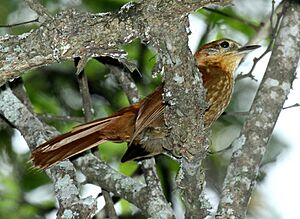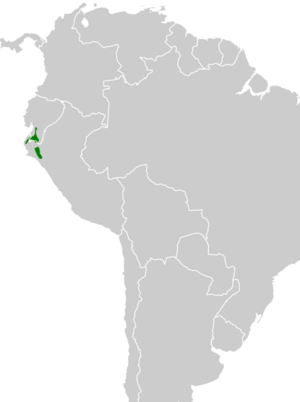Rufous-necked foliage-gleaner facts for kids
Quick facts for kids Rufous-necked foliage-gleaner |
|
|---|---|
 |
|
| Conservation status | |
| Scientific classification | |
| Genus: |
Syndactyla
|
| Species: |
ruficollis
|
 |
|
| Synonyms | |
|
Automolus ruficollis |
|
The rufous-necked foliage-gleaner (Syndactyla ruficollis) is a type of bird found in Ecuador and Peru. It belongs to the ovenbird family called Furnariidae. This bird is considered a Vulnerable species, meaning its population is at risk.
Contents
About This Bird
Bird Families and Names
Scientists group living things into families. The rufous-necked foliage-gleaner is part of the ovenbird family. It was once placed in a different group called Automolus. However, new studies in 2011 showed it belongs in the Syndactyla group. This bird is also a "sister species" to the lineated foliage-gleaner. This means they are very closely related. The rufous-necked foliage-gleaner is a "monotypic" species. This means it does not have any different subspecies or types.
What It Looks Like
The rufous-necked foliage-gleaner is a medium-sized bird. It is about 18 to 19 centimeters (7 to 7.5 inches) long. It weighs between 29 and 39 grams (1 to 1.4 ounces). Both male and female birds look the same.
This bird has a bright orange-red stripe above its eye. This stripe goes all the way to the back of its neck. It has a dark brownish band behind its eye. The feathers around its eyes and ears are a mix of gray, brown, and buff colors. Below its eye, the feathers are orange-red or yellowish-brown.
Its head is a dark reddish-brown. It has some blurry reddish streaks on its neck. Its back is a rich rusty brown with thin, light streaks. The lower part of its back is a redder brown. Its tail is a dark chestnut color. Its wings are a rich rusty brown.
The bird's chin is a pale yellowish color. Its throat is a deeper yellow-brown. Its chest is olive-brown with blurry reddish-yellow streaks. Its belly is a medium olive-brown. The sides of its body are slightly darker brown with a reddish tint. The feathers under its tail are dark reddish. Its eyes are brown. Its beak is dark brown to black on top and pale brown or gray on the bottom. Its legs and feet are grayish-olive or olive-green. Young birds look a bit duller than adults. Their heads are darker, and their throat feathers have dark brown edges.
Where It Lives
The rufous-necked foliage-gleaner lives in the coastal hills of Ecuador. It is found in the El Oro and Loja provinces. It also lives in northwestern Peru, reaching as far south as the Lambayeque region.
This bird makes its home in mountain evergreen forests. It also lives in tropical forests where trees lose their leaves in dry seasons. It especially likes areas with bamboo, near streams, and in shady valleys. You can usually find it at elevations from 1,000 to 2,600 meters (3,300 to 8,500 feet) above sea level. Sometimes, it can be seen as low as 400 meters (1,300 feet) or as high as 2,900 meters (9,500 feet).
Behavior
Movement
The rufous-necked foliage-gleaner stays in the same area all year round. It does not migrate.
Feeding Habits
This bird mainly eats small creatures like arthropods (insects and spiders). It usually looks for food alone or in pairs. It often joins groups of different bird species that are feeding together. It mostly searches for food in the lower and middle parts of the forest. It picks and pokes for its prey among leaves, moss, bamboo, ferns, and plants like bromeliads. It moves along branches and tree trunks as it searches. Sometimes, it even looks for food in the leaf litter on the ground.
Reproduction
Scientists believe that the rufous-necked foliage-gleaner breeds during the wet season. This usually happens from January to May. Not much else is known about how these birds raise their young.
Vocalization
The song of the rufous-necked foliage-gleaner is described as a "harsh, nasal 'chick, chick, che-che, tirrrrrr'". This song lasts about 2 to 3 seconds. The last note goes down in pitch. Its call, used to communicate with other birds, sounds like a "sharp, nasal 'ank' or 'chech'".
Status and Protection
The IUCN (International Union for Conservation of Nature) first listed this bird as "Threatened". Since 1994, it has been listed as "Vulnerable". This means it faces a high risk of becoming endangered.
The rufous-necked foliage-gleaner lives in a small area. This area is also broken up into many small pieces. Experts estimate there are only about 1,500 to 7,000 adult birds left. This number is believed to be shrinking. A big problem is that the places where they live are disappearing. This is happening especially in areas that are not protected. Even in higher areas, habitat loss is a concern. This bird was once common, but now it is uncommon and found only in certain spots. Luckily, it does live in some protected areas in both Ecuador and Peru. These protected areas help keep its habitat safe.


